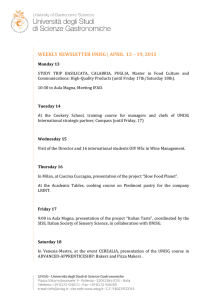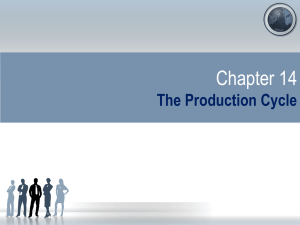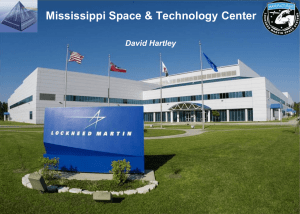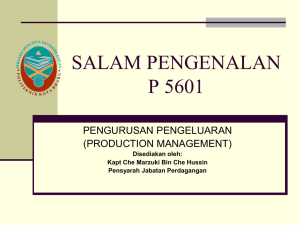bab 6 siklus produksi
advertisement
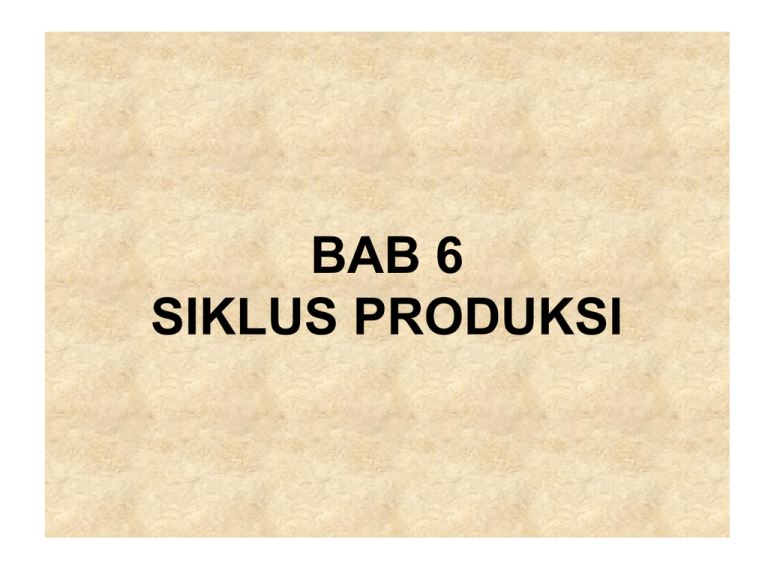
BAB 6 SIKLUS PRODUKSI AKTIVITAS SIKLUS PRODUKSI • Perancangan produk • Perencanaan dan anggaran produksi • Pelaksanaan produksi: – Konsumsi bahan baku – Konsumsi biaya tenaga kerja – Konsumsi biaya overhead produksi • Akuntansi kos dan pelaporan kegiatan produksi: unit produksi dan biaya produksi ANCAMAN SIKLUS PRODUKSI • • • • • • Desain produk tidak tepat Kelebihan/kekurangan produksi Kesalahan investasi aktiva tetap untuk aktivitas produksi Pencurian atau gangguan persediaan dan aktiva tetap. Gangguan proses produksi Laporan aktivitas produksi tidak akurat TUJUAN UMUM PERANCANGAN SIA • • • • • • Mengendalikan aktivitas produksi. Mengendalikan persediaan: baik bahan baku maupun barang jadi. Menjamin validitas dokumen produksi Menjamin keandalan pembukuan dan pelaporan aktivitas produksi. Menjamin keamanan data dan informasi produksi dan ketepatan pelaporan. Menjamin efektifitas dan efisiensi aktivitas produksi. DIAGRAM KONTEK SIKLUS PRODUKSI Permintaan pembelian Pesanan pelanggan Overhead Siklus pendapatan Prediksi penjualan Bahan baku Laporan Manajemen ga na te an uh rja ut ke i a ja ay er Bi a k g na te s uk d pro b Ke Produk jadi s Ko Sistem buku besar dan pelaporan Siklus Produksi Siklus pengeluaran Siklus Penggajian/ SDM Tujuan SIA: seluruh kegiatan produksi, termasuk arus data/informasi, dilaksanakan secara efektif dan efisien. DFD SIKLUS PRODUKSI Produk jadi Siklus pendapatan Prediksi penjualan inta Perm Bill of materials Desain produk Operation list PDP Produk jadi Kos Planning dan scheduling lian mbe e p an Siklus pengeluaran Bahan baku Order produksi Order produksi, permintaan bahan baku & move ticket Siklus SDM/ penggajian Akuntansi kos Laporan Manajemen Kartu jam kerja, move tickets, dan permintaan bahan baku Kos produksi Sistem buku besar dan pelaporan Operasi produksi Bahan baku dan biaya overhead AKTIVITAS DAN DOKUMEN • Desain produk, dokumen yang umum digunakan: – – • Daftar kebutuhan bahan (bill of material) Daftar teknis pelaksanaan produksi (operation list). Perencanaan dan penjadwalan produksi, dokumen yang umum digunakan: – Daftar rencana kegiatan produksi (master production schedule) AKTIVITAS DAN DOKUMEN – – – • Pesanan produksi (production order) Permintaan bahan (material requisition) Slip alur produksi (move ticket) Pembelian persediaan, dokumen yang umum digunakan: – – – Pesanan pembelian Laporan penerimaan barang Voucher utang dagang. AKTIVITAS DAN DOKUMEN • Penggajian, dokumen yang umum digunakan: – – – • Kartu jam kerja (timecard) Kartu produksi Otorisasi gaji (salary authorization). Transfer barang dalam proses ke dalam persediaan barang jadi, dokumen yang umum digunakan: – Laporan barang jadi (completed production order). AKTIVITAS DAN DOKUMEN • Biaya overhead pabrik, dokumen yang umum digunakan: – Berbagai dokumen atau daftar biaya produksi tak langsung, misalnya daftar penyusutan mesin produksi, daftar biaya pemeliharaan mesin produksi, dan berbagai daftar biaya produksi tidak langsung lainnya. SISTEM AKUNTANSI KOS Tujuan akuntansi kos: 1. Menyediakan informasi untuk perencanaan, pengawasan, dan evaluasi kegiatan produksi. 2. Menyediakan informasi biaya produksi, untuk kepentingan keputusan kombinasi produk (product mix). 3. Menyediakan informasi untuk kepentingan penyusunan laporan keuangan. JENIS SISTEM AKUNTANSI KOS • • Sistem kos pesanan (job costing system), digunakan pada proses produksi berdasarkan pesanan. Biaya produksi diakumulasi berdasarkan pesanan dengan menggukan kartu pesanan (job cost sheet) Sistem kos proses (process costing system), digunakan pada proses produksi masal. Biaya produksi dikumpulkan berdasarkan periode produksi/departemen produksi. PROSES PEMBUKUAN • • Sistem manual: jurnal, buku besar biaya produksi (biaya bahan baku, biaya tenaga kerja, dan biaya overhead pabrik), buku pembantu biaya produksi, dan rekapitulasi biaya produksi (berlaku baik pada kos proses maupun kos pesanan) Sistem berbantuan komputer: sama dengan sistem manual, hanya saja entri data (bisa) dilakukan hanya sekali, selanjutnya distribusi dan rekapitulasi biaya dijalankan dengan menggunakan program komputer. LAPORAN PROSES PRODUKSI • • Laporan pengendalian produksi (control report), berisi informasi lengkap kegiatan produksi, mulai dari perencanaan, penjadwalan, pelaksanaan, dan berbagai masalah produksi yang ada. Laporan biaya produksi (production cost reports), berisi informasi lengkap biaya produksi, baik secara total maupun per unit. KEPUTUSAN PRODUKSI • • • • Kombinasi dan jenis produk yang harus dibuat untuk memaksimumkan keuntungan (product mix). Penentuan harga jual (product pricing) Perencanaan dan alokasi sumber daya (resource allocation and planning), misalnya keputusan tentang membuat sendiri atau membeli suatu produk, tingkat keuntungan relatif antar jenis produk dst. Perencanaan dan pengawasan biaya produksi dan evaluasi kinerja(cost management). COMPUTER INTEGRATED MANUFACTURING (CIM) • • • • Perbedaan jenis barang yang diproduksi dan perbedaan teknologi membuat perbedaan pola produksi. Computer integrated manufacturing (CIM) ditujukan untuk menurunkan biaya produksi. Akuntan harus memahami pengaruh CIM terhadap SIA. Salah satu pengaruh CIM adalah pergeseran dari produksi masa (mass production) ke dalam produksi khusus (custom order manufacturing). PERAN AKUNTAN DALAM PROSES PRODUKSI • • • • • 65% sampai 80% biaya produksi ditentukan pada tahap disain produk. Akuntan adalah penyedia informasi tentang pengaruh disain produk terhadap biaya produksi dan tingkat keuntungan yang akan diraih. Keputusan produksi ditentukan oleh prediksi tingkat keuntungan dari kegiatan produksi. Di tangan akuntan, fungsi pengendalian anggaran produksi untuk memastikan efektifitas dan efisiensi proses produksi. Akuntan bertanggungjawab memastikan kesesuaian SIA dengan teknik produksi yang berlaku. SISTEM AKUNTANSI KOS MANUAL Penjualan Persediaan Kontrol Produksi Order Penjualan Order Penjualan Laporan Pesanan B Mengeluarkan material Permintaan material Laporan Pesanan Skedul Produksi A 2 Order Produksi 1 Order Produksi Menyiap kan kartu kos N 1 Order Produksi Bagian Produksi Akuntansi Kos Meminta material Permintaan material B C 2 Permintaan material A Mencatat Kos Kartu Kos Ke akuntansi keuangan Kartu Kerja D Lap. Produk jadi Menghitung kos/unit Jurnal voucher Memproduksi barang Kartu Kerja Membuat kartu kerja C Membuat laporan produk jadi Lap. Produk jadi D SISTEM INFORMASI PRODUKSI ON-LINE Bagian penjualan Prediksi dan order Bagian perencanaan produksi Bagian rekayasa produk Order pro-duksi dan & skedul Kos standar & tarif overhead Bagian persediaan Bagian produksi Spesifikasi produk Permintaan bahan baku Data produksi Pengendalian spesifikasi produksi Sistem informasi produksi on-line Buku Besar Bagian akuntansi kos CIM interface Pelaksana produksi i ks du ro lam da uk es od os Pr pr rp de Or an dia rs e Pe ul ed si Sk duk o pr ur ed i os as Pr per o an na u gu ak ng n b Pe aha b Data base siklus konversi Sistem pemrosesan inquiry Informasi status produksi Bagian penjualan Informasi status produksi Informasi analisis kos produksi Informasi kinerja produksi Bagian perencanaan produksi Bagian akuntansi kos Bagian pengendalian produksi Instruksi & skedul SISTEM INFORMASI PRODUKSI ON-LINE Karakteristik sistem: • • • • Seluruh data produksi dikumpulkan dalam data base kegiatan produksi. Setiap bagian harus memasukkan data kegiatan produksinya ke dalam sistem data base. Seluruh bagian harus memperhatikan informasi dalam data base untuk melihat kegiatan atau perintah yang harus dilaksanakan. Informasi didistribusikan ke seluruh divisi produksi secara elektronik. SISTEM ERP (ENTERPRISE RESOURCE PLANNING) Pelanggan Entry order Produksi Pengecekan sediaan & SDM; penjadwalan produksi Order pembelian bahan baku Pemasok Sediaan Kebutuhan SDM SDM SDM ENTERPRISE RESOURCE PLANNING • ERP merupakan perwujudan dari konsep lean manufacturing dengan tujuan meminimumkan, baik persediaan bahan baku, barang dalam proses maupun persediaan barang jadi, karena persediaan memerlukan biaya, misalnya biaya pengelolaan dan penggudangan. • ERP dikembangkan dengan cara mengintegrasikan informasi tentang pesanan konsumen, pesanan ke pemasok bahan baku, dan informasi kebutuhan SDM. METODE PERENCANAAN PRODUKSI 1. Manufacturing resource planning (MRP-II), metode ini adalah pengembangan dari konsep materials resource planning (MRP). Tujuan MRP-II: – Menyeimbangkan kapasitas produksi dengan kebutuhan bahan baku – Menyesuaikan jumlah produksi dengan prakiraan pesanan, oleh sebab itu disebut “push manufacturing”. METODE PERENCANAAN PRODUKSI 2. Just-in-time (JIT) manufacturing. Sasaran JITM adalah meminimumkan persediaan bahan baku, barang dalam proses, dan barang jadi. Barang hanya diproduksi berdasar pesanan konsumen, dan karenanya disebut “pull manufacturing”. Dalam praktik JITM dijalankan berdasarkan rencana produksi jangka pendek. Perbedaannya dengan MRP-II terletak pada jangka waktu perencanaan. JITM jauh lebih pendek dari MRP-II. AKUNTANSI AKTIVA TETAP PRORUKSI • • Penggunaan aktiva tetap produksi, misalnya gedung pabrik, mesin pabrik, dan fasilitas produksi yang lain, mengakibatkan terjadinya BOP. BOP atas penggunaan fasilitas produksi harus dicatat dan dibebankan ke produk dengan tepat. ACTIVITY BASED COSTING (ABC) Masalah krusial dalam penentuan kos produksi adalah pembebanan BOP, karena BOP tidak bisa diidentifikasi langsung ke masing-masing jenis produk. ABC ditujukan untuk menganalisis dan mengalokasikan BOP secara tepat, tidak hanya didasarkan pada pertimbangan subyektif, misalnya berdasar jam mesin atau unit produksi. ACTIVITY BASED COSTING (ABC) Sistem akuntansi tradisional mendapatkan kritik karena tidak mampu memberikan informasi biaya dengan tepat untuk kepentingan manajemen produksi, karena dua alasan: 1. Alokasi biaya overhead pabrik tidak tepat. 2. Analisis kinerja produksi kurang komprehensif mengabaikan aspekaspek non finansial. ALOKASI BIAYA OVERHEAD PABRIK Alokasi BOP pada sistem kos tradisional: • Menggunakan volume-driven based, seperti jam kerja langsung atau jam mesin. • Metode alokasi berbasis volume produksi mengakibatkan ketidaktepatan perhitungan kos produksi, karena BOP tidak selalu berbanding lurus dengan volume produksi. TUNTUTAN KONTROL PRODUKSI • Di lingkungan industri maju, perhatian utama manajemen adalah pada total quality management. • Pengendalian produksi memerlukan informasi komprehensif, yang terdiri dari informasi finansial dan non finansial. • Dalam sistem kos tradisional informasi produksi terbatas pada data biaya, sehingga kinerja operasional tidak bisa diukur secara komprehensif. ALTERNATIF SOLUSI ABC Dikatakan activity-based costing karena dalam sistem ini biaya overhead ditelusur ke dalam aktivitas yang menyebabkan munculnya biaya. ABC vs TRADITIONAL COST SYSTEM • ABC mengidentifikasi hubungan sitiap aktivitas produksi (cost driver) dengan biaya overhead pabrik, sementara sistem akuntansi tradisional cenderung membebankan BOP secara proporsional dengan unit produksi. ABC vs TRADITIONAL COST SYSTEM • ABC menggunakan pusat kos (cost pools) lebih banyak untuk biaya overhead pabrik. Sistem akuntansi kos tradisional mengumpulkan biaya overhead pabrik hanya dalam dalam satu pusat kos, yaitu rekening BOP. ABC membedakan tiga kategori biaya overhead, yaitu: – Batch-related overhead, – Product-related overhead, dan – Companywide overhead. ABC vs TRADITIONAL COST SYSTEM • ABC mengalokasikan biaya overhead pabrik ke masing-masing produk berdasarkan cost driver. Cost driver adalah apapun yang telah menyebabkan dan mempengaruhi timbulnya BOP. Manfaat ABC • • Better decision, data biaya lebih rinci dan akurat sehingga keputusan bisa menjadi lebih teliti. Improve cost management, dengan data biaya yang rinci dan akurat manajemen mampu mengawasi dan mengendalikan biaya produksi dengan lebih baik. BIAYA KUALITAS • Informasi biaya kualitas membantu manajemen dalam menentukan pengaruh kebijakan kontrol kualitas terhadap peningkatan keuntungan. • Kategori biaya kualitas: – Prevention costs, biaya untuk mencegah produk cacat. – Inspection costs, biaya untuk standarisasi kualias. – Internal failure costs, biaya untuk inspeksi pra distribusi. – External failure costs, konsekuensi adanya produk rusak yang sampai di tangan konsumen, misalnya kerugian karena runtuhnya reputasi perusahaan. Appendix Chapter 7 The Conversion Cycle Accounting Information Systems, 5th edition James A. Hall Evolusi Praktik Produksi A World Class Company… • Adalah perusahaan yang telah mencapai standar tinggi dan telah melakukan perubahan mendasar dari bentuk organisasi dan manajemen tradisional ke yang berkelas dunia. • Melakukan perubahan berkelanjutan di seluruh aspek operasi organisasi, termasuk prosedur produksi. • Sangat berorentiasi ke konsumen. Mencapai Status Kelas Dunia • Perusahaan kelas dunia memerlukan metode produksi dan sistem informasi baru yang mampu: – – – – Menginformasikan profil konsumen Mengidentifikasi produk-2 menguntungkan Mengidentifikasi konsumen yang menguntungkan Mengidentifikasi peluang untuk peningkatan kualitas operasional dan kualitas produk – Mendorong adopsi value-added activities dan proses, serta mengidentifikasi aktivitas yang tidak memberi nilai tambah – Mampu secara efisien mendukung beragam pengguna sistem dengan informasi keuangan dan non keuangan. The Conversion Cycle… • transforms input resources, raw materials, labor, and overhead into finished products or services for sale. • consists of two subsystems: – the production system – the cost accounting system Production System • Involves the planning, scheduling, and control of the physical product through the manufacturing process – determining raw materials requirements – authorizing the release of raw materials into production – authorizing work to be conducted in the production process – directing the movement of work through the various stages of production Production Methods • Continuous Processing creates a homogeneous product through a continuous series of standard procedures. • Batch Processing produces discrete groups (batches) of products. • Make-to-Order Processing involves the fabrication of discrete products in accordance with customer specifications. Documents in the Batch Production System • Sales Forecast - expected demand for the finished goods • Production Schedule - production plan and authorization to produce • Bill of Materials (BOM) - specifies the types and quantities of the raw materials and subassemblies used to produce a single finished good unit Documents in the Batch Production System • Route Sheet - details the production path a particular batch will take in the manufacturing process – sequence of operations – time allotted at each station • Work Order - uses the BOM and route sheet to specify the exact materials and production processes for each batch Documents in the Batch Production System • Move Ticket - records work done in each work center and authorizes the movement of the batch • Materials Requisition - authorizes the inventory warehouse to release raw materials for use in the production process Production Planning and Control Sales Forecast Raw Materials Requirements Inventory Status Report Engineering Specifications BOM and route sheets (Purchase Requisitions) Operations Requirements Production Scheduling work orders move tickets materials requisitions open work orders work centers job tickets time cards completed move tickets cost accounting payroll prod. plan. and control Upon Completion of the Production Process… Finished Product and Closed Work Order Finished Goods Warehouse Closed Work Order Inventory Control status report of raw materials and finished goods Prod. Plan. and Control journal voucher General Ledger EOQ Inventory Model • Objective: minimize total inventory costs while ensuring that adequate inventories exist to meet current demand • Very simple too use, but assumptions are not always valid – demand is known and constant – ordering lead time is known and constant – total cost per year of placing orders decreases as the order quantities increase – carrying costs of inventory increases as quantity of orders increases – no quantity discounts EOQ Inventory Model Inventory Cycle Daily Demand EOQ Reorder Point Lead Time Time (days) Cost Accounting System • Records the financial effects of the events occurring in the production process • Initiated by the work order • Cost accounting clerk creates a new cost record for the batch and files in WIP file • The records are updated as materials and labor are used Elements of the Cost Accounting System Inventory Control Work Centers materials requisitions job tickets completed move tickets COST ACCOUNTANTS STANDARDS Update WIP accounts DL DM Mfg. OH. Compute Variances Cost Accounting System • Receipt of last move ticket signals completion of the production process – clerk removes the cost sheet from WIP file – prepares a journal voucher to transfer balance to a finished goods inventory account and forwards to the General Ledger department Summary of Internal Controls Internal Controls • Transaction authorizations – work orders reflect a legitimate need based on sales forecast and the finished goods on hand – move tickets authorized signatures from each work station authorize the movement of the batch through the work centers – materials requisitions authorize the warehouse to release materials to the work centers Internal Controls • Segregation of duties – production planning and control department is separate from the work centers – inventory control separate from materials storeroom and finished goods warehouse – cost accounting function accounts for WIP and should be separate from the work centers in the production process Internal Controls • Supervision – supervisors in the work centers oversee the usage of raw materials in the production process to ensure that all released materials are used in production and waste is minimized – employee time cards and job tickets are checked for accuracy Internal Controls • Access control – direct access to assets • storerooms, production work centers, and finished goods warehouses • quantities in excess of standard amounts should require approval – indirect access to assets • materials requisitions, excess materials requisitions, and employee time cards Internal Controls • Accounting records – pre-numbered documents – work orders – cost sheets – move tickets – job tickets – material requisitions – WIP and finished goods files Internal Controls • Independent verification – cost accounting reconciles material usage (material requisitions) and labor usage (job tickets) with standards • variances are investigated – GL dept. verifies movement from WIP to FG by reconciling journal vouchers from cost accounting and inventory subsidiary ledgers from inventory control – internal and external auditors periodically verify the raw materials and FGs inventories through a physical count Trends in Competitive Advantage The World-Class Environment and Manufacturing Flexibility • Customers: – want quality products – want them quickly – want variety • Achieving manufacturing flexibility incorporates four operational characteristics: – – – – physical reorganization of the production facilities automation of the manufacturing process reduction of inventories high product quality Physical Reorganization of the Production Facilities • Inefficiencies inherent in the layout of traditional plants add handling costs, conversion, time, and excess inventories to the manufacturing process. • Employees tend to feel ownership over their stations, which is contrary to a team concept. • The reorganization is based on flows through cells which shorten the physical distance between the activities, thus reducing setup and processing time, handling costs, and inventories in the flow. Progression of Automation in the Manufacturing Process Traditional Islands of Technology Process Simplification (JIT) Computer Integrated Manufacturing Progression of Automation toward World-Class Status Automation of the Manufacturing Process • Traditional: – consists of many different types of machines which require a lot of setup time – machines and operators are organized in functional departments – WIP follows a circuitous route through the different operations • Islands of Technology: – stand alone islands which employ computer controlled machines that can perform multiple operations with less human involvement – less set up time needed Automating Manufacturing Automating Manufacturing • Process Simplification: – reduces the complexity of the physical layout – groups of CNC machines are arranged in cells to produce an entire part from start to finish – no human involvement in a cell • Computer Integrated Manufacturing (CIM): – a completely automated environment which employs automated storage and retrieval systems (AS/RS) and robotics Automating Manufacturing • Robotics: – use special CNC machines that are useful in performing hazardous, difficult, and monotonous tasks • Computer-Aided Design (CAD): – increases engineers’ productivity – improves accuracy – allows firms to be more responsive to market demands – interfaces with CAM and MRPII systems Automating Manufacturing • Computer Aided Manufacturing (CAM): – uses computers to control the physical manufacturing process – provides greater precision, speed, and control than human production processes • Manufacturing Resources Planning (MRP II): – an extension of materials requirements planning (MRP) – more than inventory management--it is a system for coordinating the activities of the entire firm Automating Manufacturing • Enterprise Resource Planning (ERP) Systems: – huge commercial software packages that support the information needs of the entire organization, not just the manufacturing functions – automates all business functions along with full financial and managerial reporting capability • Electronic Data Interchange (EDI): – external communications with its customers and suppliers via Internet or direct connection Accounting and MRP The Evils of Inventories • Inventories cost money and … – represent an investment – need to be insured and stored – can become obsolete over time • Inventories may camouflage production problems. • Willingness to maintain inventories can precipitate overproduction. Reducing Inventories • Just-in time (JIT) manufacturing is a model that fosters inventories reduction and even elimination. It is based on the following assumptions: – zero defects – zero setup time – small lot sizes – zero inventories – zero lead times and reliable vendors – team attitude Product Quality • Poor quality is expensive via scrap, reworking, scheduling delays, extra inventories to compensate for defective parts, warranty claims, and service. • Product quality is a basis on which world-class manufacturers compete • Product quality can be improved though control point methods such as statistical process control. What’s Wrong with Traditional Cost Accounting Information? • • • • Inaccurate cost allocations Time lag in reporting Financial orientation Emphasis on standard costs Activity Based Costing (ABC)… • is an information system that provides managers with information about activities and cost objects • assumes that activities cause costs and that products (and other cost objects) create a demand for activities • is different from traditional accounting system since ABC has multiple activity drivers, whereas traditional accounting has only one, e.g. machine hours Allocation of Costs Using ABC Activity Management • Managers must understand which activities should be performed and how best to perform them. – Managers should deploy resources to activities that yield maximum benefits. – Managers should seek to improve those factories most important to their customers. Activity Management Tasks • • • • • Evaluating manufacturing activities Identifying nonessential activities Identifying cost drivers Comparing activities to benchmarks Establishing links between key activities World-Class Information Systems • Integrate all functional and technological components: – basic accounting applications – ABC – materials requirements planning – capacity planning – inventory control – bill-of-materials – master productions schedule – forecasting – order entry – computer-aided design – computer-aided manufacturing – EDI communications links Need for New Performance Measures in the Information Pyramid Control Issues in the WCIS • Paperless environment - no traditional audit trail • Automatic transactions - need assurance that: – orders are placed only when inventory is needed – orders are placed only with approved vendors – the quantity of items ordered is correct – programs matching electronic controls data before initiating payment perform correctly • Networking considerations selesai
